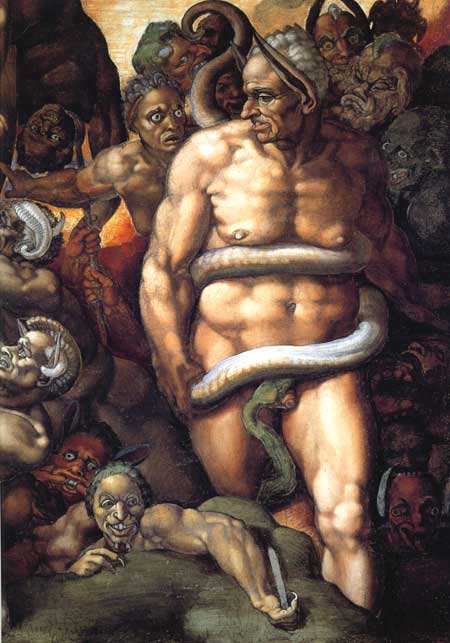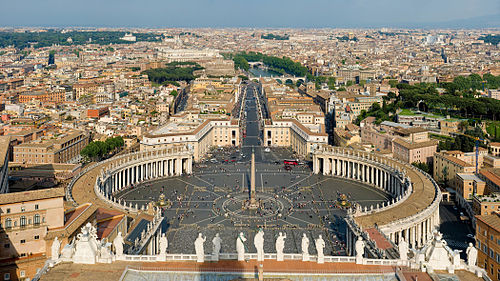We continue with more of our Rome Tour
This morning we arose in Central European Time, had breakfast in the hotel, made our lunches from the breakfast buffet and got ready for our tour of the Vatican (another “optional” tour).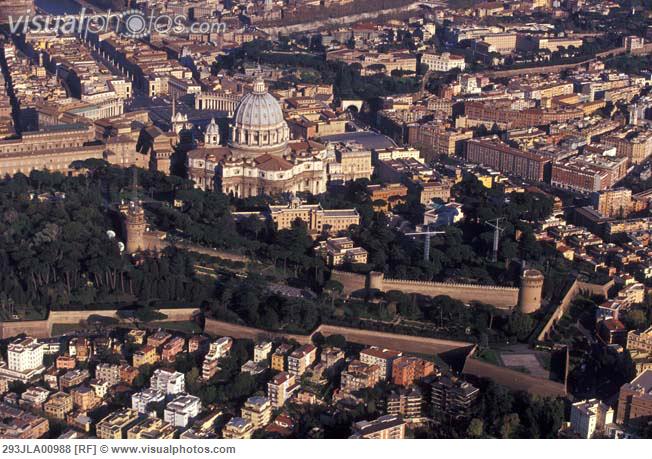 Here is an aerial view of the Vatican City/State. Note the surrounding walls and the dome of St Peter. It’s hard to believe, but true, that the Parthenon dome is bigger.
Here is an aerial view of the Vatican City/State. Note the surrounding walls and the dome of St Peter. It’s hard to believe, but true, that the Parthenon dome is bigger.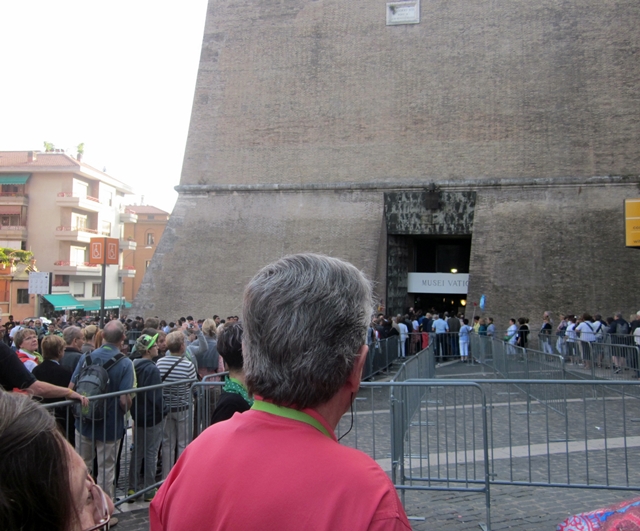 We entered via the Vatican museum through a special newly made entrance in the Vatican City wall. Our Vatican Guide had special passes that allowed us to bypass the huge crowds and go right into the museum. Maybe this was paid for by our extra costs? Hmmm…
We entered via the Vatican museum through a special newly made entrance in the Vatican City wall. Our Vatican Guide had special passes that allowed us to bypass the huge crowds and go right into the museum. Maybe this was paid for by our extra costs? Hmmm…
You had to pass through “airport-like” security to get enter. Once inside there were elbow to elbow crowds and we mostly just shuffled along. No time to stand still and stare at the Vatican treasures.
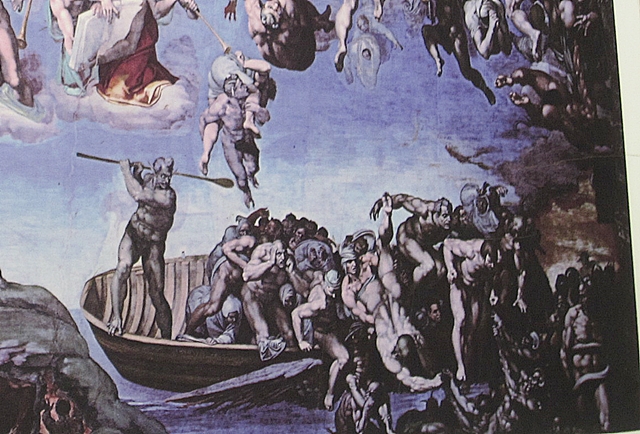 This is “The Last Judgement”. It took four years to complete and was done between 1536 and 1541. Michelangelo began working on it twenty five years after having finished the Sistine Chapel ceiling.
This is “The Last Judgement”. It took four years to complete and was done between 1536 and 1541. Michelangelo began working on it twenty five years after having finished the Sistine Chapel ceiling.
It is a depiction of the Second Coming of Christ and the final and eternal judgment by God of all humanity. The souls of humans rise on the left and descend to their fates on the right, as judged by Christ (with Mary in blue by his side). Those that “make it” float above in heaven.
The Pope’s own Master of Ceremonies Biagio da Cesena said of the painting “it was mostly disgraceful that in so sacred a place there should have been depicted all those nude figures. The genitalia in the fresco, referred to as ‘objectionable,’ were painted over with drapery after Michelangelo died in 1564.
Michelangelo worked Cesena’s face into the scene as Minos, judge of the underworld (far bottom-right corner of the painting) with Donkey ears (i.e. indicating foolishness), while his nudity is covered by a coiled snake that is actually biting his genitals. “Last laugh?…” This picture shows the size and scope of the Sistine Chapel. Our back is to “The Last Judgement”. The walls on both sides contain frescos: One side depicts the life of Christ (New Testament), the other side depicts the life of Moses (Old Testament).
This picture shows the size and scope of the Sistine Chapel. Our back is to “The Last Judgement”. The walls on both sides contain frescos: One side depicts the life of Christ (New Testament), the other side depicts the life of Moses (Old Testament).
Picture this small chapel jammed with thousands of tourist admiring the art. as the mummering increased a booming voice from above thundered “SILENCIO” and we’d stop talking for a few moments. This is a bit of detail from one of the “Jesus” frescos.
This is a bit of detail from one of the “Jesus” frescos.
 The ceiling of the chapel contains more paintings by Michelangelo. He and his assistants did these ceiling panels 25 years before “The Last Judgement”. There is much to see here, perhaps too much, but the one that most people seem to look for is “The Creation of Adam”.
The ceiling of the chapel contains more paintings by Michelangelo. He and his assistants did these ceiling panels 25 years before “The Last Judgement”. There is much to see here, perhaps too much, but the one that most people seem to look for is “The Creation of Adam”.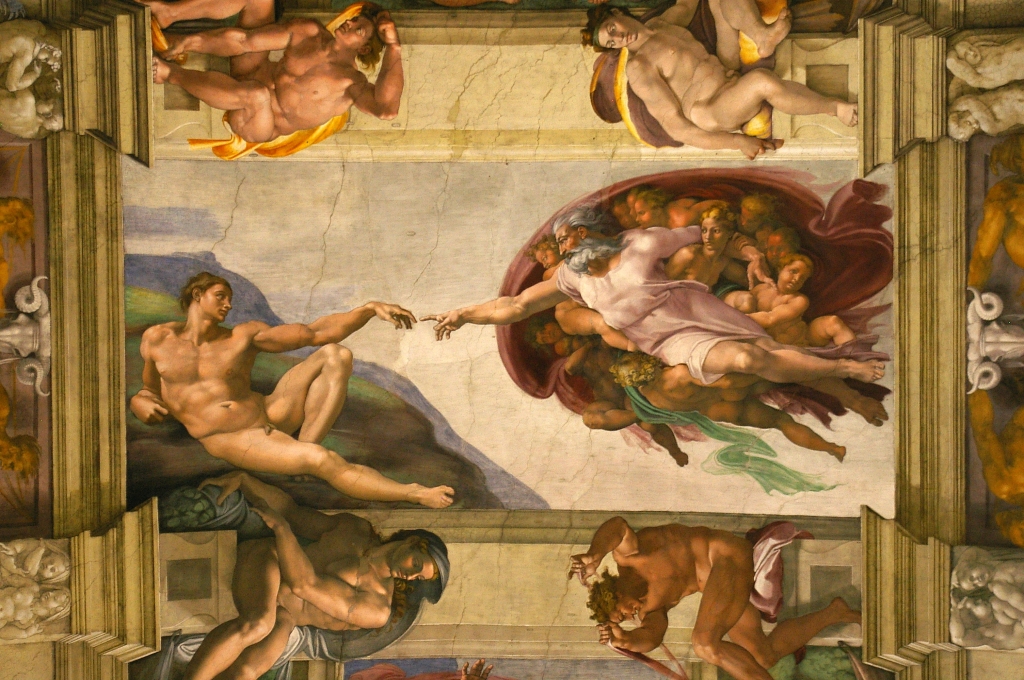 Here it is. Almost in the center of the ceiling. God is depicted as an elderly white-bearded man wrapped in a swirling cloak while Adam is completely nude. God’s right arm is outstretched to impart the spark of life from his own finger into that of Adam, whose left arm is extended in a pose mirroring God’s, a reminder that man is created in the image and likeness of God
Here it is. Almost in the center of the ceiling. God is depicted as an elderly white-bearded man wrapped in a swirling cloak while Adam is completely nude. God’s right arm is outstretched to impart the spark of life from his own finger into that of Adam, whose left arm is extended in a pose mirroring God’s, a reminder that man is created in the image and likeness of God
Alternatively, it has been observed that the red cloth around God has the shape of a human uterus and that the scarf hanging out, colored green, could be a newly cut umbilical cord. According to Enrico Bruschini, “This is an interesting hypothesis that presents the Creation scene as an idealized representation of the physical birth of man. It explains the navel that appears on Adam, which is at first perplexing because he was created, not born of a woman.”.
Enough of the Sistine Chapel. Let’s move on…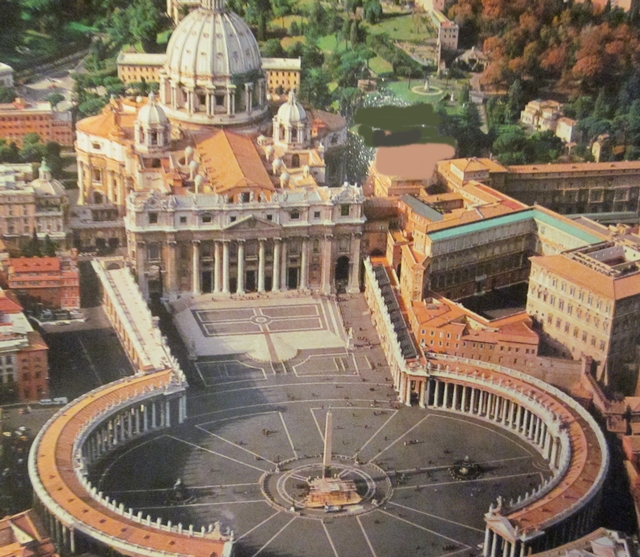 Here’s our helicopter view of St Peters Basilica and Square. St. Peter’s is the most renowned work of Renaissance architecture and remains one of the largest churches in the world. While it is neither the mother church of the Catholic Church nor the Catholic Roman Rite cathedral of the Diocese of Rome, St. Peter’s is regarded as one of the holiest Catholic sites. It has been described as “holding a unique position in the Christian world” and as “the greatest of all churches of Christendom”.
Here’s our helicopter view of St Peters Basilica and Square. St. Peter’s is the most renowned work of Renaissance architecture and remains one of the largest churches in the world. While it is neither the mother church of the Catholic Church nor the Catholic Roman Rite cathedral of the Diocese of Rome, St. Peter’s is regarded as one of the holiest Catholic sites. It has been described as “holding a unique position in the Christian world” and as “the greatest of all churches of Christendom”.
By Catholic tradition, the basilica is the burial site of its namesake Saint Peter, one of the twelve apostles of Jesus and, also according to tradition, the first Pope and Bishop of Rome. Tradition and strong historical evidence hold that Saint Peter’s tomb is directly below the altar of the basilica. For this reason, many Popes have been interred at St. Peter’s since the Early Christian period.
Construction of the present basilica began in 1506 and was completed in 1626.
This is a view looking from the dome east to the Tiber River. The wide boulevard leading from the Vatican square is the Via della Conciliazione was built by Mussolini.
There is so much detail in the art and architecture of the basilica and square that it would take pages to include even a small amount of description. I’ll leave it to my diligent readers to Google it and read the details.
Let’s look inside.
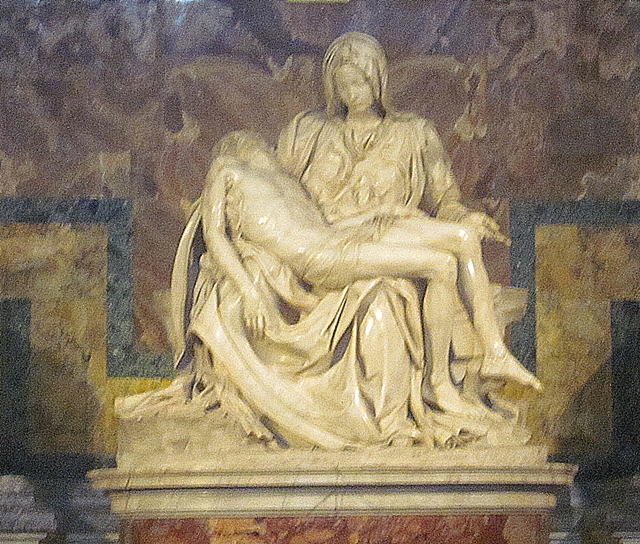 The Pietà (1498–1499) is a world-famous work of Renaissance sculpture by Michelangelo. It is the first of a number of works of the same theme by the artist. The statue was commissioned for the French Cardinal Jean de Bilhères, who was a representative in Rome. The sculpture, in Carrara marble, was made for the cardinal’s funeral monument, but was moved to its current location in the 18th century. It is the only piece Michelangelo ever signed.
The Pietà (1498–1499) is a world-famous work of Renaissance sculpture by Michelangelo. It is the first of a number of works of the same theme by the artist. The statue was commissioned for the French Cardinal Jean de Bilhères, who was a representative in Rome. The sculpture, in Carrara marble, was made for the cardinal’s funeral monument, but was moved to its current location in the 18th century. It is the only piece Michelangelo ever signed.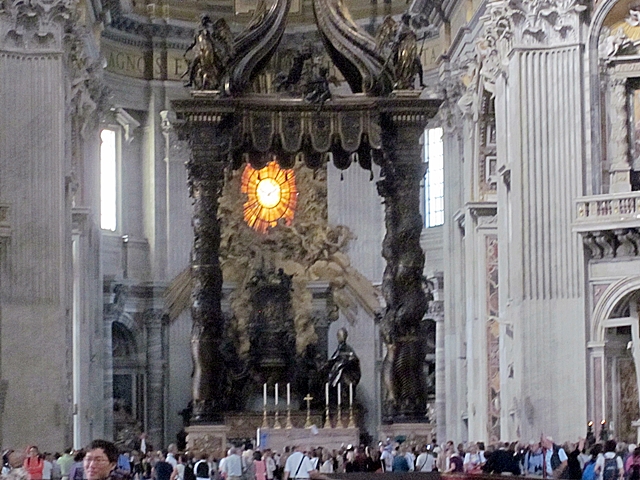 The bronze and gilded baldachin (A canopy of fabric carried in church processions or placed over an altar, throne, or dais.) was the first of Bernini’s works to combine sculpture and architecture and represents an important development in Baroque church interior design and furnishing. The canopy rests upon four helical columns each of which stands on a high marble plinth. The columns support a cornice which curves inwards in the middle of each side. Above this, four twice life size angels stand at the corners.
The bronze and gilded baldachin (A canopy of fabric carried in church processions or placed over an altar, throne, or dais.) was the first of Bernini’s works to combine sculpture and architecture and represents an important development in Baroque church interior design and furnishing. The canopy rests upon four helical columns each of which stands on a high marble plinth. The columns support a cornice which curves inwards in the middle of each side. Above this, four twice life size angels stand at the corners.
The four columns are 66 feet high. The base and capital were cast separately and the shaft of each column was cast in three sections. Their helical form was derived from the smaller marble helical columns once thought to have been brought to Rome by the Emperor Constantine from Solomon’s Temple in Jerusalem and which were used in the Old Saint Peter’s Basilica.
The source of the bronze to make the structure was an issue of contemporary controversy as it was believed to have been taken from the roof or portico ceiling of the ancient Roman Pantheon (we saw this yesterday), though by Pope Urban’s accounts say that about ninety percent of the bronze from the Pantheon was used for a cannon.
Note how the altar dwarfs the crowd. They both are huge! The dome is directly above the Altar. In St Peter’s basilica, pilgrims come to pay their respects to the bronze statue of St Peter, the first Pope and rock of the early church, over whose tomb the basilica was built.
In St Peter’s basilica, pilgrims come to pay their respects to the bronze statue of St Peter, the first Pope and rock of the early church, over whose tomb the basilica was built.
Pilgrims would bend down to kiss the foot of the statue and over the years the metal wore away so that the toes blend in with the rest of the foot. Nowadays most visitors touch the toe instead of kiss it, but the feet are still worn down with the human contact.
We spent a lot of time in the Basilica admiring the art and grandeur of the place, but finally went to the gift store to see if there were any relics still left for sale. There were none, but a shipment from China was expected soon.
 We did get a shot of a Swiss Guard.
We did get a shot of a Swiss Guard.
The Swiss were famous mercenaries for hundreds of years. Since Switzerland was a poor country, young men often sought their fortunes abroad, having a reputation for discipline and loyalty, and employing revolutionary battle tactics. They were considered the most powerful troops of the 15th century.
Currently, the name Swiss Guard generally refers to the Pontifical Swiss Guard of the Holy See stationed at the Vatican in Rome.
The Guard is a small force maintained by the Holy See, it is responsible for the safety of the Pope, including the security of the Apostolic Palace. The Swiss Guard serves as the de facto military of Vatican City.
Its first, and most significant, hostile engagement was on 6 May 1527, when 147 of the 189 Guards, including their commander, died fighting the troops of the French Holy Roman Emperor Charles V. This last in the stand of the Swiss Guard during the Sack of Rome in order to allow Clement VII to escape through the Passetto di Borgo to the Castel Sant’Angelo. More on this later.
Their oath is: “I swear I will faithfully, loyally and honourably serve the Supreme Pontiff Francis and his legitimate successors, and also dedicate myself to them with all my strength, sacrificing if necessary also my life to defend them. I assume this same commitment with regard to the Sacred College of Cardinals whenever the see is vacant. Furthermore I promise to the Commanding Captain and my other superiors, respect, fidelity and obedience. This I swear! May God and our Holy Patrons assist me!”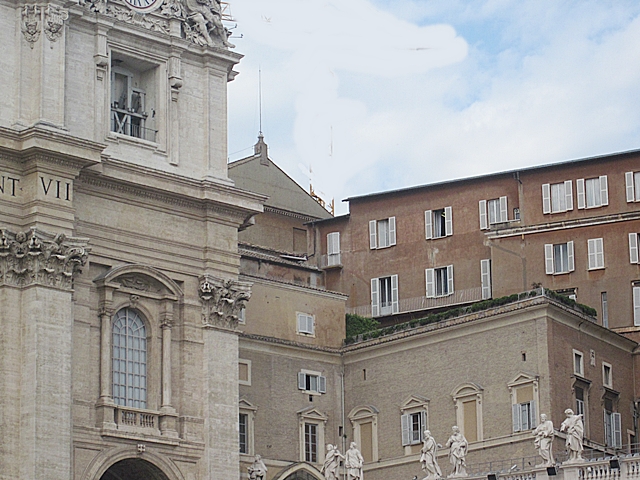 One final picture taken at The Vatican: That little peaked roof in the center is the roof the Sistine Chapel. Under that is all the chapel artwork that we’ve previously seen. The chapel is used by the College of Cardinal when electing a new Pope. There is a little temporary chimney there where the smoke (white: new Pope, black: not yet) exits. The smoke furnace is installed in the chapel during the election process, then removed.
One final picture taken at The Vatican: That little peaked roof in the center is the roof the Sistine Chapel. Under that is all the chapel artwork that we’ve previously seen. The chapel is used by the College of Cardinal when electing a new Pope. There is a little temporary chimney there where the smoke (white: new Pope, black: not yet) exits. The smoke furnace is installed in the chapel during the election process, then removed.
To the right of the chapel is the Papal Apartments. The new Pope Francis doesn’t stay there. He has a simple 2 room apartment in the clerical guest house.
We said “Arriverderci” to the Vatican and boarded our bus to the hotel. It was “lunch on our own” so Mary Ann ad I (along with Joe and Kathy from Oconomowoc, WI) hopped off the bus near the Castle Sant’ Angelo. There were long lines to get in so Mary Ann and I went to a little park nearby and enjoyed another scavenged lunch. Joe and Kathy went to a pizzaria.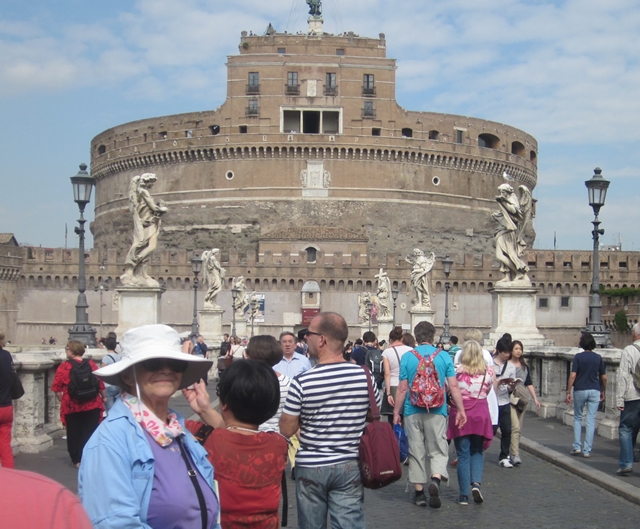 Here is the Castle and the line. When we were through with lunch, the line was gone, so we went in to look around.
Here is the Castle and the line. When we were through with lunch, the line was gone, so we went in to look around.
The Mausoleum of Hadrian, usually known as Castel Sant’Angelo (English: Castle of the Holy Angel), is a towering cylindrical building in Parco Adriano (where we ate lunch). It was initially commissioned by the Roman Emperor Hadrian as a mausoleum for himself and his family between 123 AD and 139 AD.
Originally the mausoleum was a decorated cylinder, with a garden top and a golden quadriga (here’s that word, again). Hadrian’s ashes were placed here a year after his death in 138 AD, together with those of his wife and son. Following this, the remains of succeeding emperors were also placed here, the last recorded deposition being Caracalla in 217 AD. The urns containing these ashes were probably placed in what is now known as the Treasury room deep within the building. The building was later used by the popes as a fortress and castle. The Castle was once the tallest building in Rome.
Much of the tomb contents and decorations have been lost since the building’s conversion to a military fortress in 401AD and its subsequent inclusion in the Aurelian Walls. The urns and ashes were scattered by Visigoth looters during the sacking of Rome in 410AD.
Legend holds that the Archangel Michael appeared atop the mausoleum, sheathing his sword as a sign of the end of the plague of 590, thus lending the castle its present name.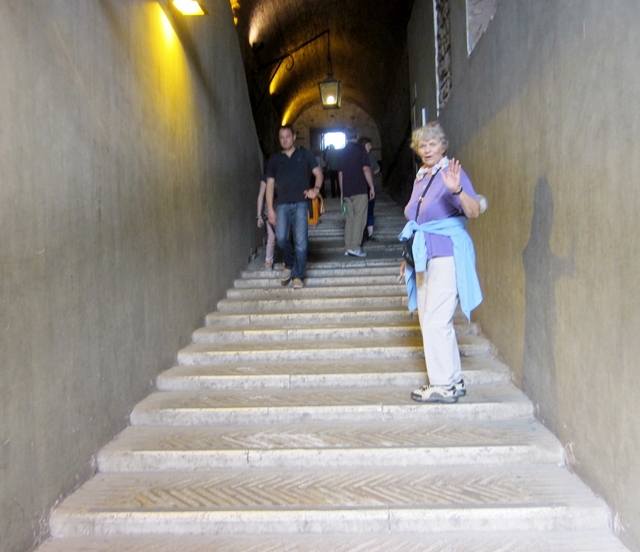 There were stairways everywhere.. In the outside walls and in the round castle.
There were stairways everywhere.. In the outside walls and in the round castle.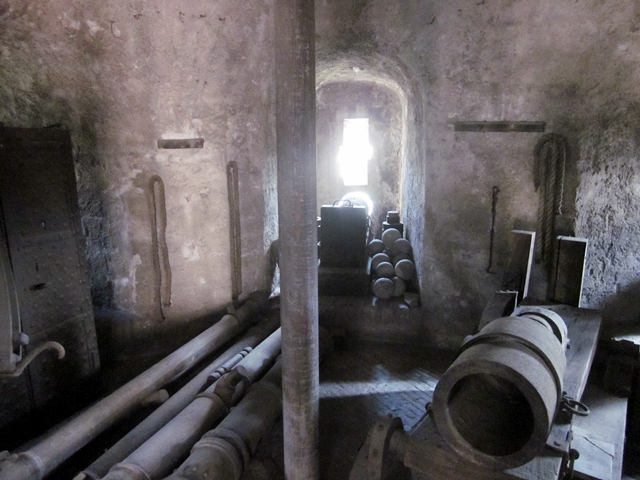 Since it was a fortress, there were lots of old cannons pointing out widows.
Since it was a fortress, there were lots of old cannons pointing out widows.
 This is the treasury room where the Emperor’s ashes were stored.
This is the treasury room where the Emperor’s ashes were stored.
Up more stairs and we reach the top level.
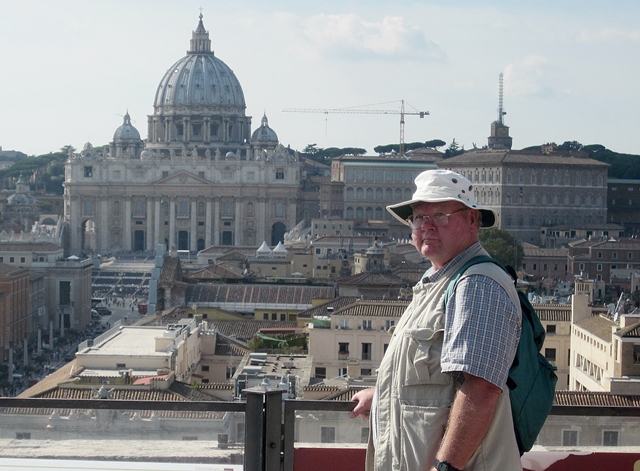 You can see how close we are to the Vatican.
You can see how close we are to the Vatican.
The popes converted the structure into a castle, beginning in the 14th century; Pope Nicholas III connected the castle to St Peter’s Basilica by a covered fortified corridor called the Passetto di Borgo (see above). The fortress was the refuge of Pope Clement VII from the siege of Charles V’ (the French “Holy Roman Emperor”) during the Sack of Rome in 1527.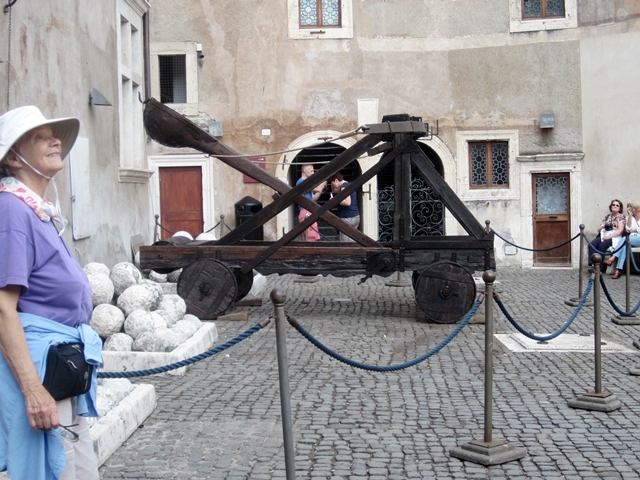 This neat catapult was on one of the upper floors. It could hurl those huge rounded boulders at unwanted visitors.
This neat catapult was on one of the upper floors. It could hurl those huge rounded boulders at unwanted visitors.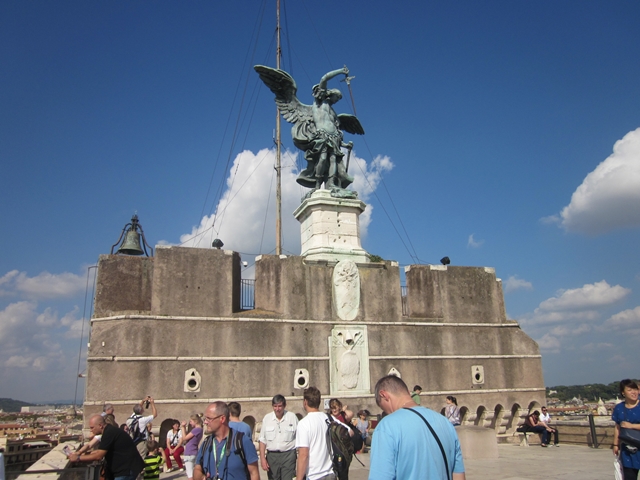 Here is the top level of the Castle. Legend holds that the Archangel Michael appeared atop the mausoleum, sheathing his sword as a sign of the end of the plague of 590, thus lending the castle its present name.
Here is the top level of the Castle. Legend holds that the Archangel Michael appeared atop the mausoleum, sheathing his sword as a sign of the end of the plague of 590, thus lending the castle its present name.
The Papal state also used Sant’Angelo as a prison; Giordano Bruno, for example, was imprisoned there for six years. He was later toasted as a heretic. Executions were performed in the small inner courtyard. As a prison, it was also the setting for the third act of Giacomo Puccini‘s “Tosca” the eponymous heroine of the opera leaped to her death from the Castle’s ramparts. Here’s a view from the top of the Castle of the Tiber River complete with a sightseeing boat and scullers.
Here’s a view from the top of the Castle of the Tiber River complete with a sightseeing boat and scullers.
We met Joe and Kathy on the way out and decided to share a taxi back to the hotel. The Roman cab driver must have been trained in Boston because he took us on a tour of the city. I had a map and I knew exactly where he was taking us. You won’t believe this, but I got pissed and spoke rather harshly to him. Joe and Kathy were chagrined and the driver turned up his radio.
Needless to say, he got no tip from me!!
 Back at the hotel, which is next to a section of the Aurelian Wall that circled and protected Rome which I discussed earlier. But I want to point out the little fence in the lower left. This is a “subway” to somewhere, but it appeared to be occupied by people.
Back at the hotel, which is next to a section of the Aurelian Wall that circled and protected Rome which I discussed earlier. But I want to point out the little fence in the lower left. This is a “subway” to somewhere, but it appeared to be occupied by people.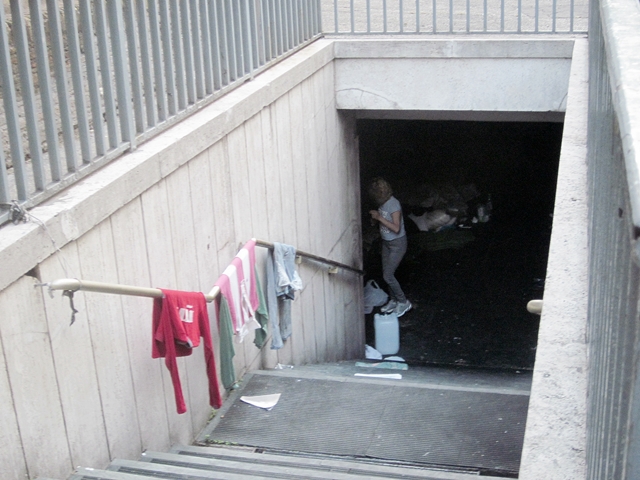 I sneaked over and took this picture. And, indeed it was occupied and it must have been washday.
I sneaked over and took this picture. And, indeed it was occupied and it must have been washday.
That was the end of that day’s wandering and the completion of our “pre-trip”. Other than griping about the added costs, the”pre-trip was great! We never would have seen so much on our own and the quick access to places saved us mucho time.
That evening we met the rest of the tour group (the non pre-trippers), had dinner with them all (on GCT’s nickle). We got introduced to Eva Troncon our Tour Director and tour guide for the rest of the trip, and were briefed on our upcoming travel plans.

